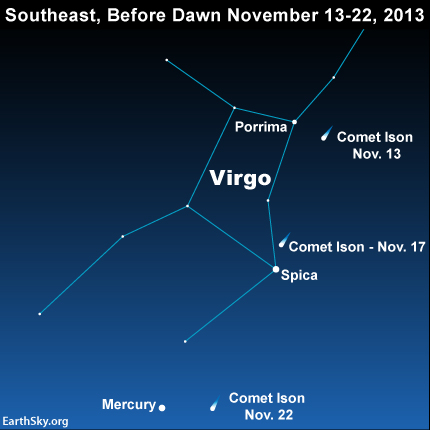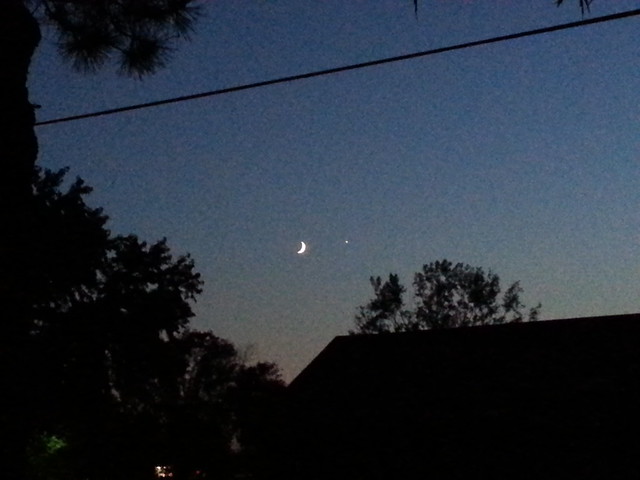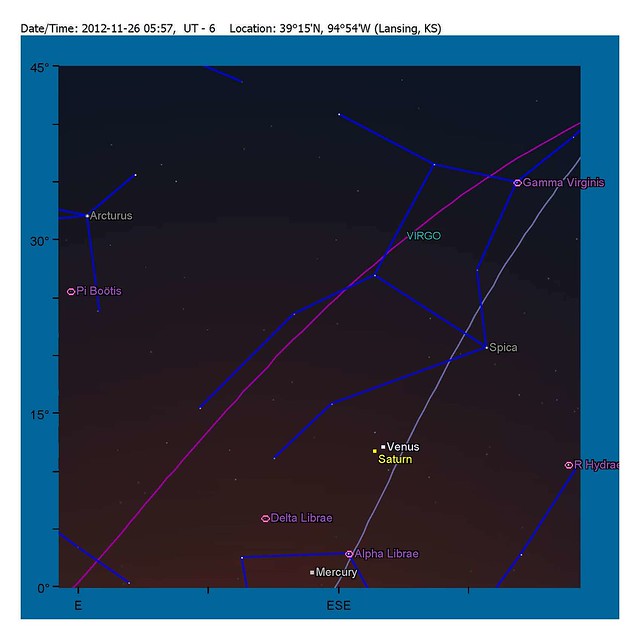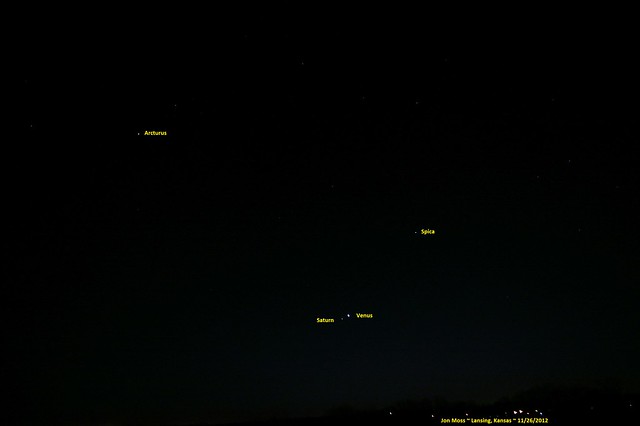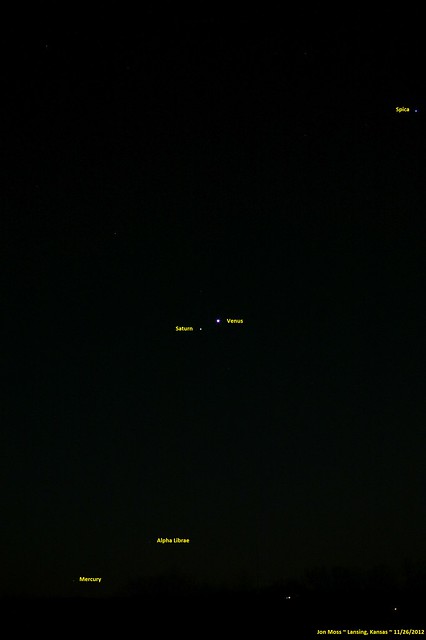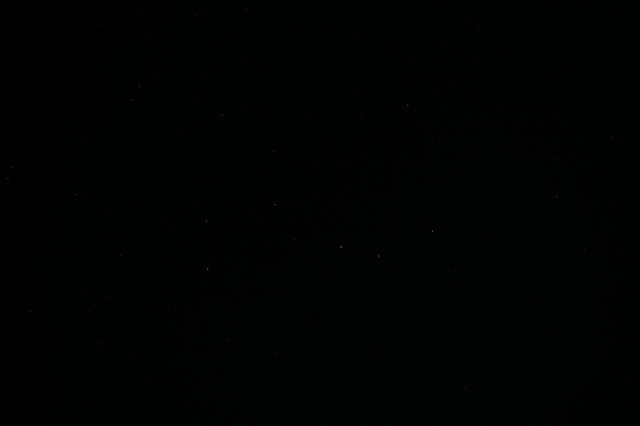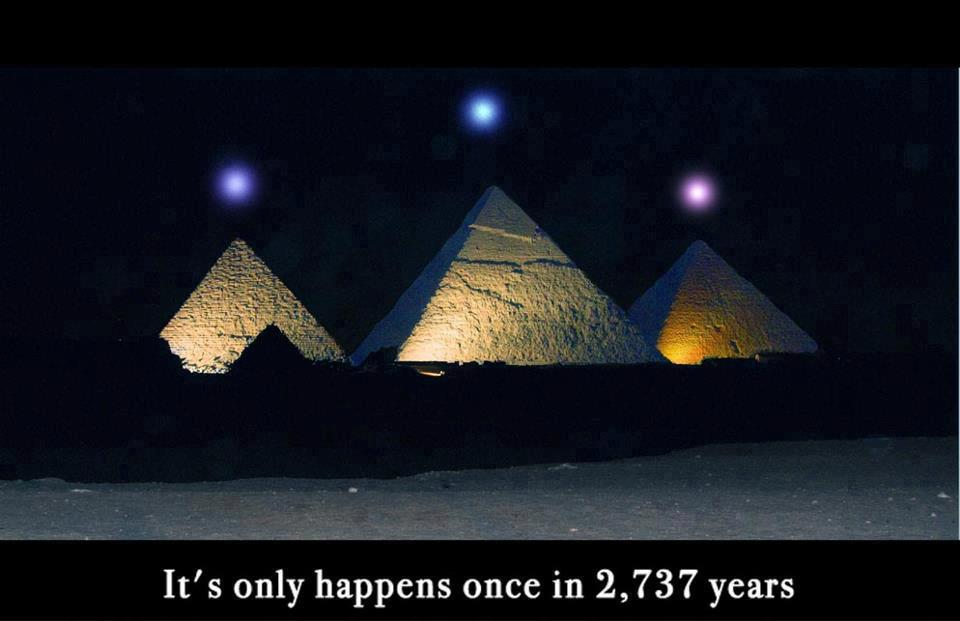I’m an early riser. I’m always up before the sun. Some mornings, like this morning, I wake up to obscured skies, clouds reflecting the ruddy golden light of Kansas City in the southeast from my bedroom window.
Tag: amateur astronomy
Moon Venus Conjunction
Most “super” supermoon of 2013 on June 22-23 | Tonight | EarthSky
Most “super” supermoon of 2013 on June 22-23 | Tonight | EarthSky.
Tonight the largest appearing moon of the year, just in time for summer.
Dew-Wop Star Hop
 Friday turned into a very long day indeed. I took the afternoon off to accompany my husband to a doctor’s visit to discuss the next steps in managing his condition. That appointment went better than I thought it would and I’m grateful for the information and the prospects. We will persevere.
Friday turned into a very long day indeed. I took the afternoon off to accompany my husband to a doctor’s visit to discuss the next steps in managing his condition. That appointment went better than I thought it would and I’m grateful for the information and the prospects. We will persevere.
We got back home with just thirty minutes to spare before venturing out again, this time a couple of miles west of us (on the other side of Lansing) to attend the grand opening of a new farmer’s market. We’ve known the family that owns the farm for years, and we love to buy locally grown produce. We didn’t stay long as I needed to research and prep for the star party at Powell.
I received the ‘all clear’ or ‘go ahead’ e-mail from the ASKC star party coordinator earlier in the afternoon. I called my dad to see if he wanted to join me. He had a conflict so I asked my husband. He preferred to stay home. So I was on my own.
First thing I needed to do was dust off the 8-inch Dob. Then I attempted to collimate it. Then I dialed in the finder scope. I didn’t remember until later that I’d purchased, back in October, a new finder scope, so I missed the opportunity to try it out. The weather forecast for the rest of the weekend doesn’t look good for more testing opportunities.
Next, I found my Astro Quest Observing checklist and started planning my overly ambitious observing list for Friday night’s star party. I’ve been working on this observing award for nearly two years now. I really need to step it up and get it done! I got a bit distracted when I realized I hadn’t recorded some of the observations I made last fall and winter. Eventually, I returned to those items I’ve yet to observe that would be the best candidates for an early June dark-of-the-moon night sky. I used my Pocket Sky Atlas and the Android App SkySafari Plus on my Samsung Galaxy Note II to select twenty items. I added these targets to a list in the app:
- R CrB
- R Leo
- 48 Librae
- Thuban (in Draco)
- Adhafera (in Leo)
- Sarin (in Hercules)
- Owl Nebula (M 97)
- Blinking Planetary Nebula
- Ghost of Jupiter Nebula
- Cat’s Eye Nebula
- Sombrero Galaxy
- Black Eye Galaxy
- M 86 (in Virgo)
- M 81 aka Bode’s Nebula
- M 22 (in Sagittarius)
- M 5
- M 7 (aka Ptolemy’s Cluster)
- IC 4665
- NGC 6231
- NGC 6210
I partially disassembled the Dob for transport, placing the tube in its carrying case. I had some concern that the base would not fit in the trunk of my car, but it did, barely. I discovered my portable emergency red light battery needed charging so I plugged it in a couple of hours before I needed to leave. I found a lawn chair and a table I could take. I forgot two items that in hindsight I should have brought with me: 1) the monopod for my binoculars (to reduce shaking while observing) and 2) Deep Woods Off or some other Deet laden bug spray. I got everything into the car, except the charging battery, and watched the clock tick down to 7:30 p.m.
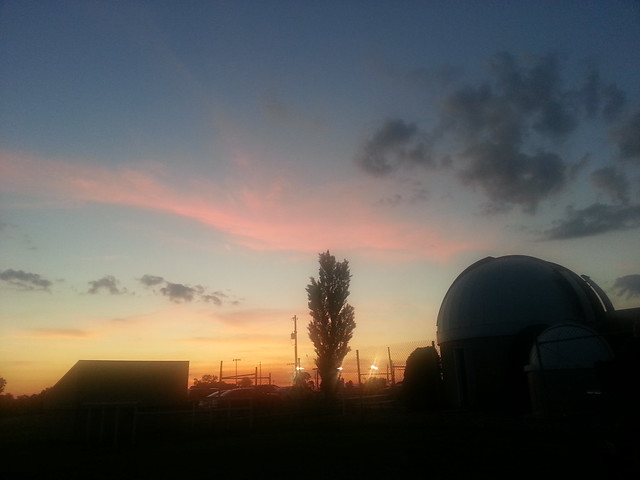 The drive to Powell Observatory near Louisburg took an hour, but I enjoyed listening to my audiobook and dodging Johnson County drivers. I arrived to a gorgeous sunset (see photos above and at right). I also noticed a baseball game in progress to the northwest of the observing field (you can see the field lights already on in the photo above). These lights became an annoyance for the next two hours.
The drive to Powell Observatory near Louisburg took an hour, but I enjoyed listening to my audiobook and dodging Johnson County drivers. I arrived to a gorgeous sunset (see photos above and at right). I also noticed a baseball game in progress to the northwest of the observing field (you can see the field lights already on in the photo above). These lights became an annoyance for the next two hours.
I opted to park in the parking light north of the observatory and across the street. Several ASKC members were already setting up their telescopes east of the dome. The parking lot to the west of the dome was filled with what I assumed to be a private party that had reserved the dome facilities for the evening. It took me three trips to get the telescope and accessories from the car to the observing field. While I made these trips, the star party coordinator informed me I could have driven my car around the dome onto the observing field to make my life easier. But I excel at doing things the hard way. Maybe next month I’ll be lazier.
I put the scope back together and checked the alignment of the finder scope. Then I settled into my lawn chair to wait for darker skies. Eventually, around 9:30 p.m., I got my binoculars out and waited for Venus, Mercury and Saturn to pop out in the twilight. I observed all three of these planets with binoculars and with the 8-inch Dob. I could clearly see that Mercury was half full (or is that more properly referred to as quarter illuminated?).
During this time (after sunset but before the ball field lights were extinguished), we saw the ISS pass over in the northern part of the sky.
I used my binoculars to locate M13 in Hercules and I used the scope to find M4 in Scorpius. I roamed around the sky with my binoculars, relaxing in my lawn chair, getting increasingly annoyed by the brightness of the ball field lights. I also started to notice an accumulation of dew on just about everything. When I would pick up my binoculars and look through them, often I would see bright halos instead of pin pricks of starlight. Any printouts I had sitting on my table quickly became sodden and unusable.
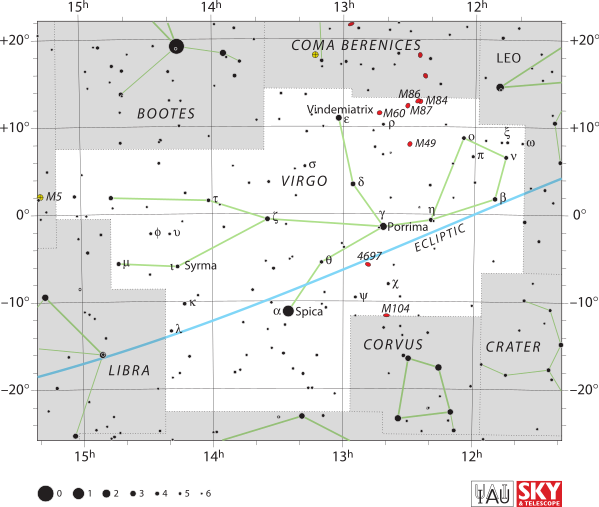 The ballgame finally wrapped up a few minutes before 10:30 p.m. We all cheered when the lights finally died and we could let our eyes adjust to the dark. Within fifteen minutes, I had found the Sombrero Galaxy (aka M 104) in the constellation Virgo. This was my first chance to really field test using SkySafari Plus on my smartphone, using the night vision setting (red display) and the ability to zoom-in to match the field-of-view I saw through my scope’s eyepiece. Made star hopping easier. No more juggling my reading glasses, a red light flashlight and my Pocket Star Atlas. To find the galaxy, I actually came up from the constellation Corvus (see chart above).
The ballgame finally wrapped up a few minutes before 10:30 p.m. We all cheered when the lights finally died and we could let our eyes adjust to the dark. Within fifteen minutes, I had found the Sombrero Galaxy (aka M 104) in the constellation Virgo. This was my first chance to really field test using SkySafari Plus on my smartphone, using the night vision setting (red display) and the ability to zoom-in to match the field-of-view I saw through my scope’s eyepiece. Made star hopping easier. No more juggling my reading glasses, a red light flashlight and my Pocket Star Atlas. To find the galaxy, I actually came up from the constellation Corvus (see chart above).
I had to abandon searching for dim nebula and the harder to find variable stars on my observing list because of the persistent haze that hung over the sky. While I was grateful for the lack of wind, this also resulted in no movement of the thin clouds. I had to focus on brighter objects. I did observe, in my binoculars, the stars Thuban, Adhafera and Sarin, but I did not attempt R CrB or 48 Librae, which require better seeing conditions to locate via star hopping.
 During the eleven o’clock hour, I set my sights on locating M5, a globular cluster, found in the constellation Serpens. I’ve tried a couple of times in the past to locate this cluster, but there are no bright stars near it to guide you to it. Since I’m trying to perfect my star hopping abilities (and didn’t bring my “goto” telescope with me), I again used the SkySafari Plus, zoomed in to with in a couple of degrees of the cluster, to find a suitable path among the faint stars. At first I attempted from the east (my left) using some stars in the Serpens constellation, but I kept getting lost (or nowhere), so I changed tactics and thought I’d try coming ‘up’ from Libra. No luck there either.
During the eleven o’clock hour, I set my sights on locating M5, a globular cluster, found in the constellation Serpens. I’ve tried a couple of times in the past to locate this cluster, but there are no bright stars near it to guide you to it. Since I’m trying to perfect my star hopping abilities (and didn’t bring my “goto” telescope with me), I again used the SkySafari Plus, zoomed in to with in a couple of degrees of the cluster, to find a suitable path among the faint stars. At first I attempted from the east (my left) using some stars in the Serpens constellation, but I kept getting lost (or nowhere), so I changed tactics and thought I’d try coming ‘up’ from Libra. No luck there either.

Finally, I moved to the west, to the right leg of the constellation Virgo, and used stars tau and 109 to draw a line due east (to the left) directly to M5. Huzzah! I found it at 11:30 p.m. I observed the cluster, as best I could with the less than stellar seeing conditions, and sat savoring the triumph of finally locating this illusive globular cluster.
 Several other star party attendees had started packing up their equipment, probably because of the dew and the haze. I wanted to stick it out, at least until midnight, so I quickly scanned through my observing list and decided to investigate the 13th constellation in the Zodiac (or rather, one of the thirteen constellations that cross the ecliptic) and find an open cluster, IC 4665. It should have been visible with binoculars, but I had little hope of that. Ophiuchus, also known as the Serpent Bearer, is a large constellation between Sagittarius and Scorpius. I used the nu and tau stars to guide me to the open cluster. I could see it well (although it barely fit in the field of view) via the scope, but could not discern it through my binoculars, which kept fogging over and became more and more useless as the night progressed.
Several other star party attendees had started packing up their equipment, probably because of the dew and the haze. I wanted to stick it out, at least until midnight, so I quickly scanned through my observing list and decided to investigate the 13th constellation in the Zodiac (or rather, one of the thirteen constellations that cross the ecliptic) and find an open cluster, IC 4665. It should have been visible with binoculars, but I had little hope of that. Ophiuchus, also known as the Serpent Bearer, is a large constellation between Sagittarius and Scorpius. I used the nu and tau stars to guide me to the open cluster. I could see it well (although it barely fit in the field of view) via the scope, but could not discern it through my binoculars, which kept fogging over and became more and more useless as the night progressed.
I still had a few minutes to go before tomorrow arrived, so I turned the scope northward, to Ursa Major, hoping to find the Owl Nebula. Unfortunately, looking north from Powell Observatory means looking back through the entirety of Kansas City and all its glorious star-obscuring light pollution. I made a half-hearted attempt to locate the nebula and decided enough was enough.
I switched on my portable battery and it’s ’emergency’ red light (in non-flashing mode) so I could see my observing site well enough to start packing up the equipment. Everything was soaked in dew. Thank goodness my Pocket Sky Atlas is designed for moisture-laden environments. The paper it’s printed on isn’t traditional paper. I suspect a high content of plastic.
Three trips later, I had everything back in the car. I pulled out of the parking lot at six minutes past midnight and pulled into my driveway an hour later. I went straight to bed.
Final thoughts? I was able to check off three of the twenty items from my observing target list. Not nearly as many as I had hoped to find, but given the conditions, I’m satisfied with the results. I’ll give it another go next month and as I can from my backyard, weather permitting.
Comet and Crescent Moon Sail into the Sunset
 You can tell it’s spring time in Kansas by my frustration with clouds and astronomical observing. I don’t grumble much, so long as the clouds provide relief for our record drought, as they did last weekend with two days of good rain on top of the melting snow left over from Winter Storms Q and Rocky. I decided to skip, again, the ASKC‘s Messier Marathon, scheduled for Monday evening, mostly because it fell on a week night, but also because the clouds did not appear to be cooperating. And the drive home, westward, did not fill me with confidence for my odds of spotting comet PanSTARRS and the thin crescent moon, potentially one of the youngest I’d yet observed.
You can tell it’s spring time in Kansas by my frustration with clouds and astronomical observing. I don’t grumble much, so long as the clouds provide relief for our record drought, as they did last weekend with two days of good rain on top of the melting snow left over from Winter Storms Q and Rocky. I decided to skip, again, the ASKC‘s Messier Marathon, scheduled for Monday evening, mostly because it fell on a week night, but also because the clouds did not appear to be cooperating. And the drive home, westward, did not fill me with confidence for my odds of spotting comet PanSTARRS and the thin crescent moon, potentially one of the youngest I’d yet observed.
Upon arriving home, clouds still obscured the sun sporadically to the west. My husband and I grabbed a quick bite to eat at the local Arby’s and I walked Apollo upon returning home, despite the brisk wind out of the northwest. I had just sat down to watch something with Terry when I checked out the window one last time. Miraculously, the western horizon appeared cloud free. I handed Terry the remote, shoved on my boots, grabbed the camera, binoculars and tripod and ran to the van. As I drove west along Eisenhower Road, I received a call from my Dad, who was back in Lansing, at the spot where we observed the Transit of Venus last June. I told him I was heading to a small rural church parking lot at the corner of Eisenhower and County Shop Road, because it has slightly less light pollution than the hill overlooking Main Street (K-7/US-73) in Lansing.
I arrived about ten minutes before eight o’clock. I uncapped my binoculars and took a quick look at the thin crescent moon, one of the slimmest ones I’ve yet observed. Later, I calculated it was also the youngest I’ve observed, just twenty-nine (29) hours old. Here’s the photo I took of it fifteen minutes later, after I’d setup the tripod and put the telephoto lens on my camera:
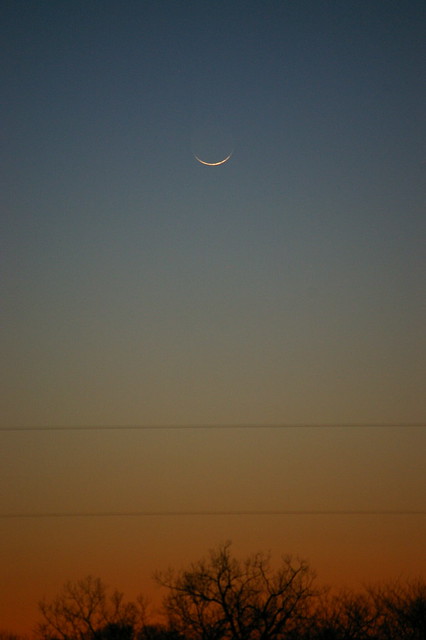
I continued to take photographs for another twenty-five minutes but never did find the comet with my naked eyes. Using my binoculars, I did locate comet PanSTARRS about a quarter after eight. When I reviewed my photographs after downloading them to my computer, I realized I’d actually captured it earlier, in a photo taken one minute after the one shown above. The best shot of the crescent moon and the comet came another fifteen minutes later though:
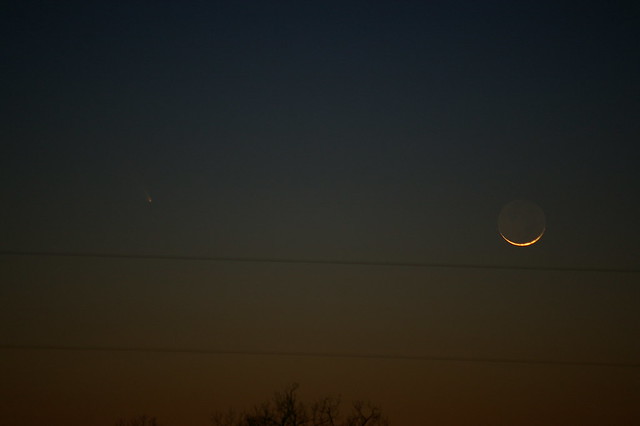
I plan to keep trying for the rest of the week, or as long as comet PanSTARRS is visible. I may even drive down to Powell Observatory Friday evening. I read an announcement via the Astronomical Society of Kansas City‘s Twitter feed declaring a special pre-season opening of the observatory to view the comet.
I called my dad back, since we’d gotten cut off by bad cell phone reception out in the county. He confirmed his inability to spot the comet without optical aid and wished me a good night. I packed up the equipment and returned home. I fed the dogs while I downloaded the photos to Terry’s computer and quickly reviewed them, selecting a few of the better shots to upload to Flickr to share with family and friends. By that time, I needed to hit the sack, so I left writing this blog until morning.
Happy hunting to all of you this week. Grab a pair of binoculars and look west, young men and women, look west for comet PanSTARRS.
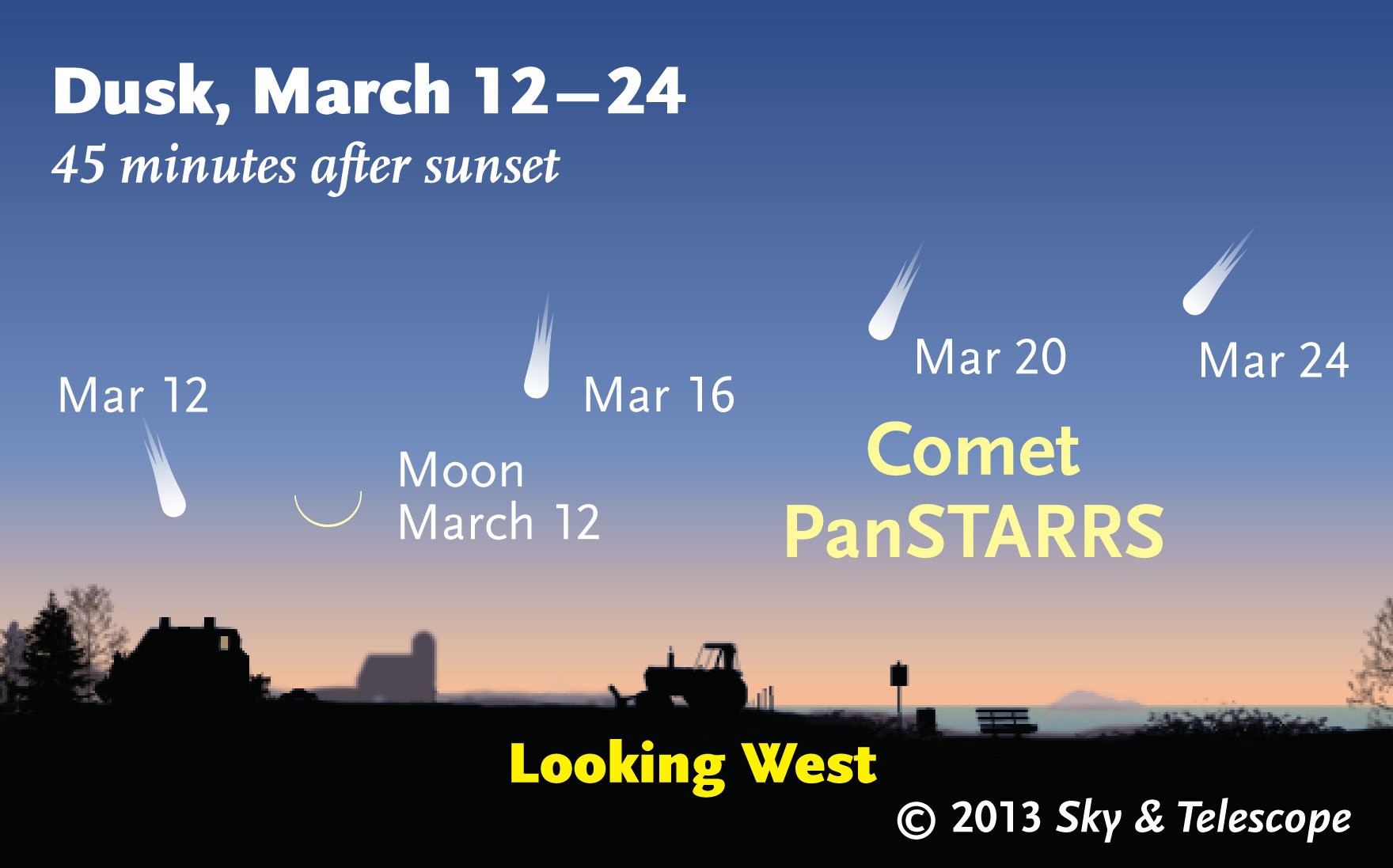
Space Weather with Dr. Patterson
My father and I drove to UMKC Saturday evening to attend the first club meeting of 2013 for the Astronomical Society of Kansas City. We went an hour early to take in Astro 101 (topic: telescope mounts).
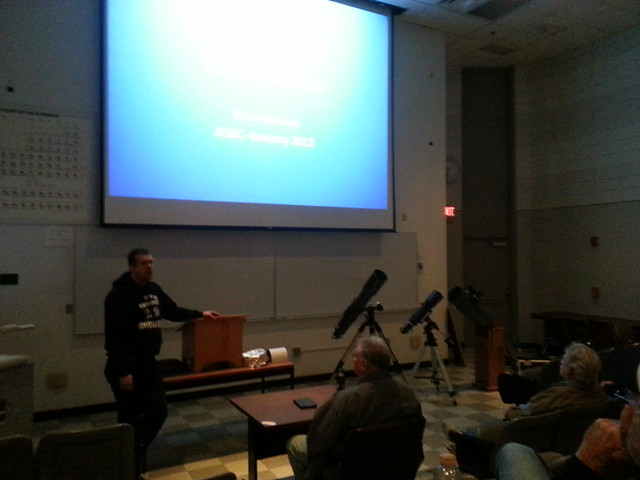
After sifting through club business, including some great observing awards and a new observing program for asterisms, our Education director, Jay Manifold, flashed through the observing highlights for the upcoming months. He paused at the end long enough to introduce our special guest speaker, Dr. Doug Patterson, Professor of Astronomy and Physics at JCCC, and his topic “Space Weather: Understanding the Sun-Earth Connection.”
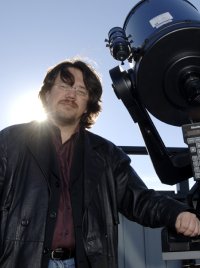 Dr. Patterson’s first slide, at first glance, did not appear to be related directly to space or weather. He explained that besides astronomy and physics, his other abiding passion happened to be photographing race cars. For the past twenty years, despite appearing quite youthful and brimming with energy, he’s been teaching astronomy and physics at the Johnson County Community College.
Dr. Patterson’s first slide, at first glance, did not appear to be related directly to space or weather. He explained that besides astronomy and physics, his other abiding passion happened to be photographing race cars. For the past twenty years, despite appearing quite youthful and brimming with energy, he’s been teaching astronomy and physics at the Johnson County Community College.
Astronomy in academia really only requires a research computer and spreadsheet program. Incredible amounts of data (terabytes upon terabytes) are freely available for astronomical researchers.
Dr. Patterson joked that he frequently tells his students that “Space is not empty!”
Highlights from his “Space Weather” talk:
- Super Flare 1859 observed by Carrington (on 9/1/1859 around noon). The flare took seventeen (17) hours to read Earth.
- Birkeland and his aurora machine

-
Solar Wind discovery and proof
- comet tails
- Super-Sonic Model by Eugene Parker confirmed by Mariner 2 on way to Venus.
- Voyager 1 is beyond solar wind and actually in interstellar space (first man-made ‘spaceship’ to be truly interstellar).
Dr. Patterson showed a video of the corona and sun from NASA’s solar satellites. He also displayed an animation of a coronal mass ejection (CME).
Fluctuations in the solar wind compress our magnetic field. Some of the effects on Earth include:
- compression and fluctuations
- electrical conductors embedded in Earth’s mag field
- radiation & navigation airline flights over arctic
- interference with GPS (and Google Maps)
- In Mar 1989, we (the Earth) learned the hard way (Quebec w/o power for three (3) days).
As a result, NASA launched the Advanced Composition Explorer (real time plots available here of solar wind data), which gives us one (1) hour advanced warning. This satellite is parked in a halo orbit at L1. Real time space weather data is available at spaceweather.com.
Van Allen Belts
- Discovered by Explorer 1, the first satellite we launched into orbit

- We just sent our second probe last year, a gap of over fifty years
- Trapped radiation and particles
- Why study the belts?
- Low Earth Orbit (LEO) very cluttered
- GPS already in the belts
The Van Allen Probes (fka Radiation Belt Storm Probes) were launched last year and Dr. Patterson had the privilege of witnessing the launch first hand, despite hurricane Isaac. Note to self: Rocket ion trails make great lightning rods.
Dr. Patterson concluded with a Q&A opportunity where several ASKC members asked cogent questions and received animated responses.
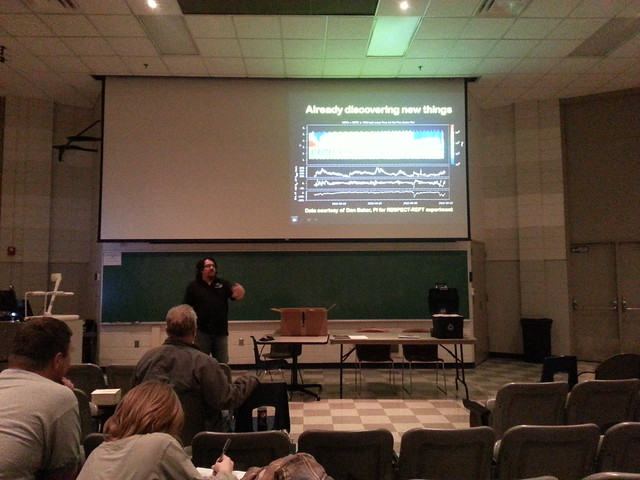
Due to the warmth of the evening (upper 40s or lower 50s), the club opened up the Warko Observatory on the roof of Royall Hall for a brief time. A haze obscured nearly everything except the full moon and Jupiter. Dad and I skipped the climb to the roof and headed home to Leavenworth.
Orion Rising
I went outside Wednesday evening to photograph our exterior Christmas lighting decorations. As I walked down the front steps, I could see most of Orion rising in the east. The Hunter seemed to be reclining in a dreamy, wispy, foggy pose. I couldn’t resist taking a couple of photos, the best of which is displayed below:
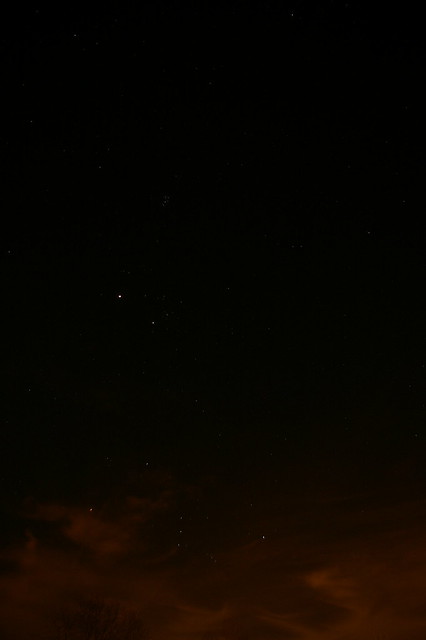
Venus Dives Past Saturn
Twelve degrees Fahrenheit this morning as I setup the tripod and camera for the third pre-dawn photo shoot of Saturn and Venus. Completely calm, unlike yesterday morning, so no jiggles to the camera, beyond my fumbling numb fingers. I opted for longer exposures (three or four seconds), so I ended up with some trails, especially when using the telephoto lens. Otherwise, much the same as before, with the exception of the planetary dance partners.
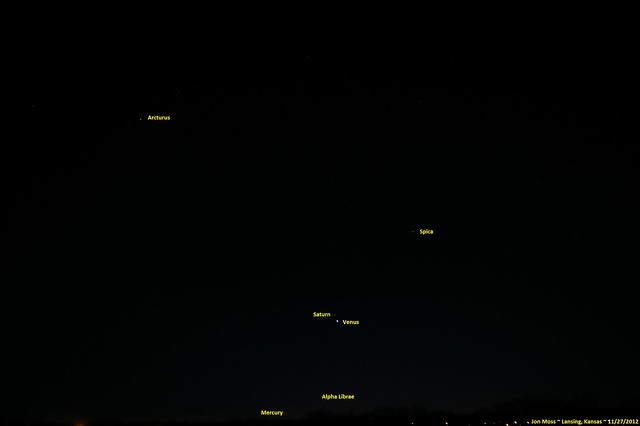
I don’t plan on repeating this for a fourth time tomorrow morning, but I do plan on trying to capture the full moon as it approaches Jupiter tomorrow night. There also happens to be a penumbral lunar eclipse occurring Wednesday evening.
Wednesday, November 28
Full Moon arrives at 9:46 a.m. EST. It appears against the background stars of Taurus the Bull before dawn this morning, approximately midway between the Pleiades and Hyades star clusters and below brilliant Jupiter. (The Moon will slide within 1° of the planet after sunset tonight.) But the Moon has a lot more going for it today. First, it passes through the outer part of Earth’s shadow. This penumbral lunar eclipse will slightly darken the Moon’s northern half. People in much of North America can see the eclipse’s early stages, which begin at 7:15 a.m. EST. (Those in Australia, eastern Asia, and the Pacific islands have the best views of the event.) Second, this Full Moon is the smallest (29.4′ in diameter) of 2012. Our satellite’s relatively diminutive size arises because it reaches the farthest point in its orbit around Earth at 2:37 p.m. EST today, when it lies 252,501 miles (406,362 kilometers) from Earth’s center. (Astronomy.com ‘The Sky This Week – November 23 – December 2, 2012’)
Saturn Squeezing Venus
I went to bed Sunday night lamenting the end of my longest vacation in over a decade. I double-checked and triple-checked my return-to-work checklist (security badge, laptop, cell phone, sunglasses, lunch bag, work clothes and shoes, etc.) before nodding off. I woke up fifteen minutes before my alarm went off at five o’clock. I jumped out of bed and had myself dressed and ready to go before half past five. I wanted to make sure I didn’t miss this morning’s Saturn-Venus photo opportunity.
I got everything, including the camera and tripod, packed into the back of the van and drove up the hill, squinting through the frosty windshield, to the library parking lot. I left the van running with the defroster on half-blast, but turned off the headlights. I setup the tripod and camera on the sidewalk, but quickly became concerned by the slight breeze from the north, which could (and did) jiggle the camera during the longer exposures necessitated by the pre-dawn darkness.
I changed lenses on the camera back to my normal lens and took a couple of wide angle shots to begin with:
I adjusted the brightness (something I rarely do since I don’t own Photoshop and need to learn how to use Gimp) to make the horizon a bit more visible.
Shortly after six o’clock, I observed Mercury and took a photo in portrait orientation (vertical) to include all three planets and the star Spica:
Because I needed to begin the commute to work at a quarter past six, I had to stop taking photos early. A good thing, too, since my batteries, which I had just put in before yesterday morning’s photo session, had already depleted due to the cold temperatures and long exposure times. I did take the time to switch back to my telephoto lens to zoom in on several of the prime targets.
I managed to snatch a closeup of Venus and Saturn and of Mercury and Alpha Librae before I packed up the equipment and left for work:
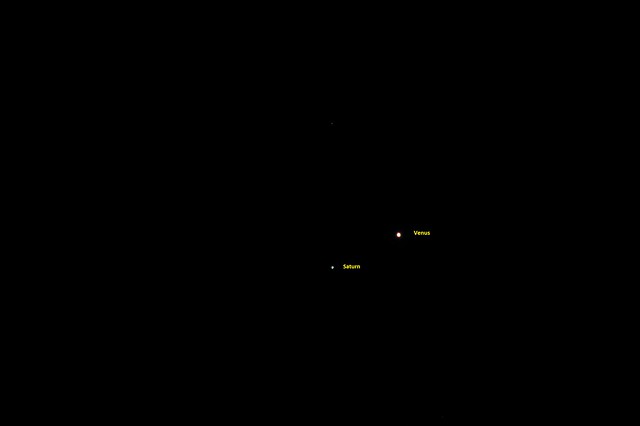

Tomorrow morning, weather permitting clear skies, I will attempt to capture Saturn as it slips past and above Venus.
Begining of the End
I learned last night at the November general meeting of the Astronomical Society of Kansas City that we have just fifty days (forty-nine as I write this blog) until the end of a Mayan age (the 13th Bak’tun). More commonly known to us as the Winter Solstice on December 21, 2012 (12/21/12 or 21/12/12 depending on your longitude). I had a lot on my mind as I drifted off to sleep last night, but when I woke to clear skies and a newly risen Venus blinking at me through the bare branches of trees along my eastern horizon, I shook off the last vestiges of ancient doom and gloom and braved the brisk late fall pre-dawn environs with my tripod and camera.
Armed with new tips and techniques garnered from Tom Martinez’s astrophotography presentation during the club’s Astro 101 session, I attempted a long exposure (ten seconds long) of the Big Dipper using my normal lens:
I was gratified to discover that my camera can take even longer exposures without the necessity of a handheld remote. Not that I don’t plan to purchase a remote for it soon though.
I didn’t attempt to capture Canis Major or Orion in a long exposure since I would have been shooting west over the well-lit parking lot of City Hall. Instead, I turned my camera towards the southeast and bright shining Venus and the slightly dimmer Saturn.
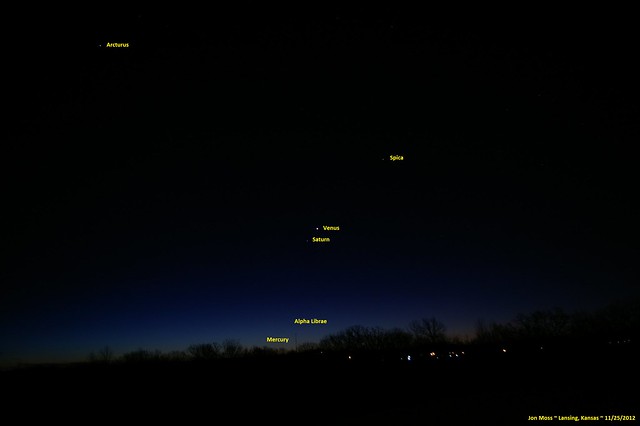
I knew Mercury had risen shortly after six o’clock, but I couldn’t see it clearly until about a quarter after.
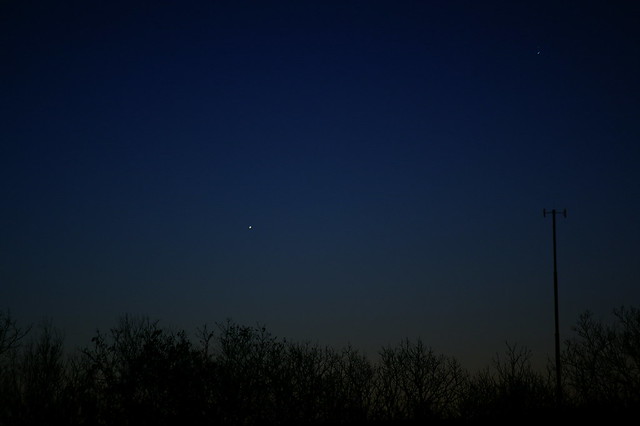
Later, I accidentally captured not only Mercury, but a passing plane, as it took off from KCI (northeast of my location).
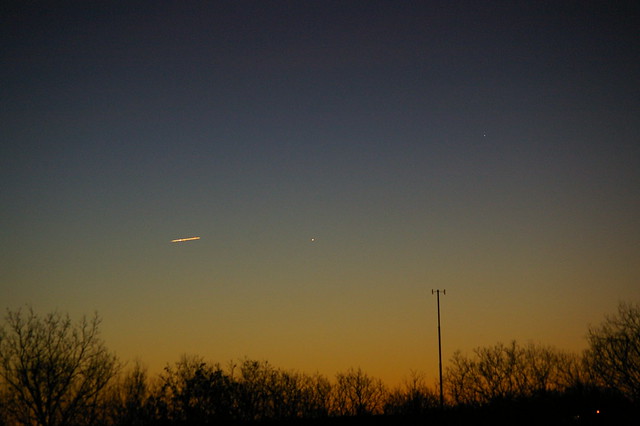
When I got back to my laptop and downloaded the photos, I also double-checked and compared them to the alignment at the time they were taken using the Star Dome Plus java applet at Astronomy.com:
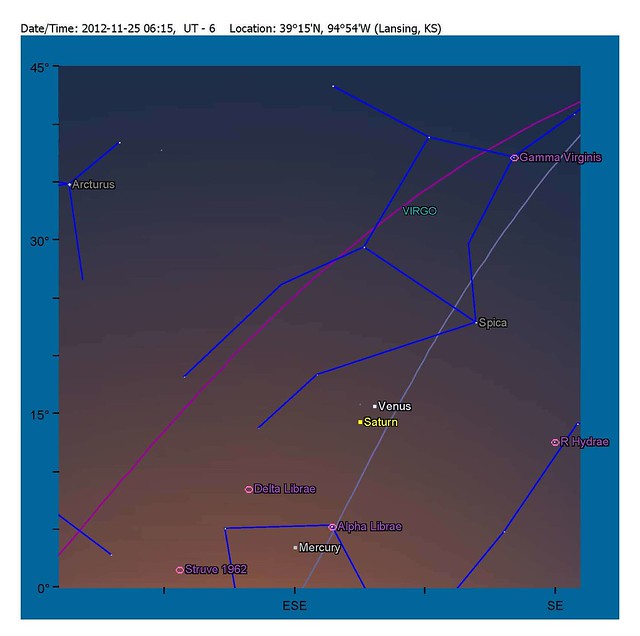 A short successful photo shoot this morning. I didn’t hang around for the sunrise, since I judged it wouldn’t be as pretty as the one I captured Saturday morning.
A short successful photo shoot this morning. I didn’t hang around for the sunrise, since I judged it wouldn’t be as pretty as the one I captured Saturday morning.
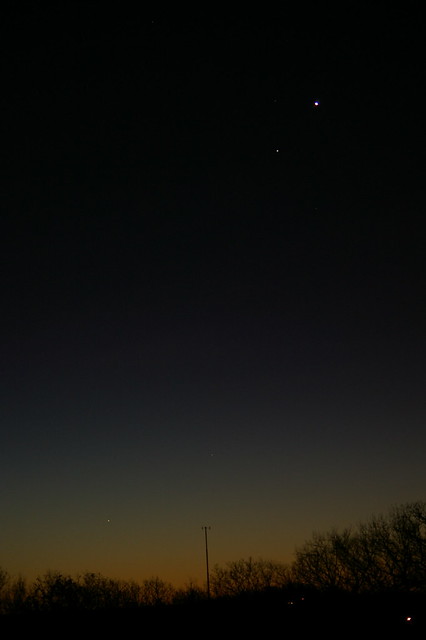
Weather permitting, I’ll be repeating this activity for the next two or three mornings. I’m excited to see Venus and Saturn pass each other in the night (or very early morning).
And next week I’m going to wish I was visiting Egypt to witness a once in 2,737 years event involving these same three planets and the Great Pyramids at Giza.

